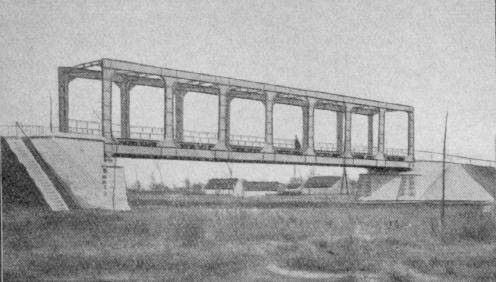Vierendeel carrier
The Vierendeel girder is a girder made up of contiguous square frames, each made up of four bars .
In contrast to the half-timbered girders with bar triangles, a rectangular Vierendeel girder built into facades or walls enables conventional rectangular windows, doors or passages to be attached to the spaces in between. Vierendeel girders are also only used as part of the structure of multi-storey buildings. Walls inserted into the spaces contribute to the overall strength.
In contrast to half-timbered girders, however, the connection points between the bars must be designed to be rigid . According to the usual treatment of the soft corner connections as joints in structural engineering , a bar with such simple corner connections would be statically underdetermined , i.e. H. to be regarded as useless, all possible forms acceptable support system . An advantage over a (statically not overdetermined) truss girder is that a Vierendeel girder remains operational to a limited extent if a vertical bar fails, but a truss immediately loses its function if any bar fails. Due to the necessary stiff corners, a Vierendeel girder is a statically indeterminate structure, but that weighs more heavily: it is heavier and more expensive than a lattice girder.
The Vierendeel girder is named after the Belgian engineer Arthur Vierendeel (1852-1940) who developed and used it as a bridge girder with rectangular fields (see figure below, left). Later Vierendeel bridges are u. a. Arched bridges that contain only three sides of the original square bar (see figure below, middle). The parallel vertical bars have remained a special feature. Basically it should be noted that the relatively thick bars of Vierendeel bridges caused by the necessary corner stiffness look more like beams . Today, large (with lanes) are no longer built, but pedestrian bridges are still being built as Vierendeel bridges (see figure below, right).
Examples
- Vierendeel girder bridges
Gustav Heinemann pedestrian bridge with Vierendeel girders in front of Berlin Central Station , 2005
- Vierendeel girders in the facade of the Commerzbank high-rise in Frankfurt am Main .
- The top nine floors of the 56 Leonard Street skyscraper in Manhattan, each with different large cantilevers and mutual offsets.
Individual evidence
- ^ Janine Brun support structure made of steel, the Vierendeel-Täger , Lucerne University of Applied Sciences
literature
- Karl Kriso: Statik der Vierendeelträger , Springer 1922
- Karl-Eugen Kurrer : The History of the Theory of Structures. Searching for Equilibrium . Berlin: Ernst & Sohn 2018, pp. 802ff., ISBN 978-3-433-03229-9 .
Web links
- Vierendeel girders, structurae
- Vierendeelträger (examples, website by Karel Roose)



